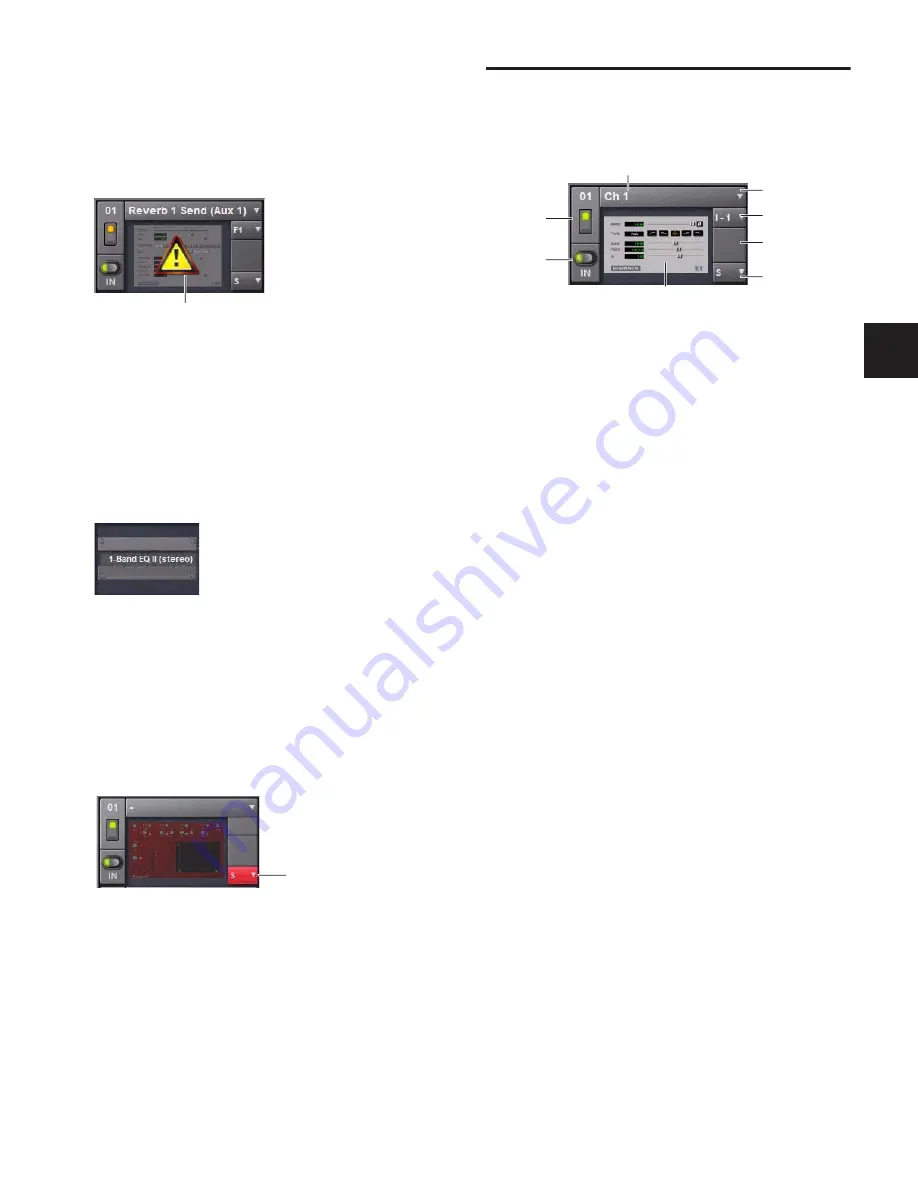
Chapter 19: Plug-Ins
151
Unavailable Plug-Ins
When a plug-in cannot be used because of insufficient DSP re-
sources, because it is disabled, or because it is not installed on
the system, a warning icon is shown in front of the affected
plug-in. The plug-in icon is greyed out, and the rack slot
Power switch displays a yellow switch LED.
For more information, see “Installing and Authorizing
Plug-Ins” on page 145.
Inactive Plug-Ins
When a plug-in has been manually made inactive, the plug-in
icon is greyed out. Plug-Ins can be made inactive manually,
letting you retain their assignment and settings in the rack
while freeing up their DSP resources for other tasks.
For more information, see “Active and Inactive Plug-Ins” on
page 153.
Scope Indication in the Plug-Ins Page
The Plug-In Rack provides visual indication whenever a
plug-in is scoped in the currently targeted snapshot. The
Snapshot pop-up menu turns red whenever that plug-in is
scoped by the currently targeted snapshot.
For more information, see “Plug-In Presets and Snapshots” on
page 158.
Rack Slots
Each rack provides 25 plug-in slots. You can assign any in-
stalled plug-in to any available rack slot.
Each rack slot provides the following controls to select and
manage plug-ins:
Power (Config Mode Only)
Power turns the rack slot on or off. When off, the plug-in con-
sumes no DSP.
In/Out (bypass)
The In/Out switch takes the rack slot in or out of circuit (by-
passes the slot and any plug-in assigned to it).
Input
The Input pop-up menu determines plug-in input (source).
Use this menu to designate the plug-in as a channel insert or
a bus processor by choosing from the Inserts or Bus
sub-menus. For more information, see “Routing Plug-Ins” on
page 153.
Once a plug-in has been routed, its input source is displayed
in the Input area of each rack slot, as follows:
• If the plug-in is being used as an insert, the channel or
bus name and number is shown, for example,
Kick (Ch 1)
or
Aux (1–2)
. The Channel Insert/Bus Output selector au-
tomatically switches to Channel Insert mode, showing
the insert point occupied by the plug-in.
• If the plug-in is on a bus, the selected bus source is shown
in the Input selector, for example,
Aux 1
or
Grp 1
. The
Channel Insert/Bus Output selector can be used to assign
the output routing of the plug-in to a channel or bus.
Indication of an unavailable plug-in
Indication of an inactive plug-in
Indication of a scoped plug-in
Unavailable plug-in
Scoped (Snapshot menu red)
A rack slot and its controls, with an assigned plug-in shown
In/Out
Power
Channel Insert
Snapshots
Input (source)
Plug-In
or Output
Assigned plug-in
Current routing assignment
selector
Summary of Contents for D-Show Profile
Page 10: ...D Show Profile Guide x ...
Page 11: ...Part I Overview and Installation ...
Page 12: ......
Page 16: ...D Show Profile Guide 6 ...
Page 32: ...D Show Profile Guide 22 ...
Page 33: ...Part II System Description ...
Page 34: ......
Page 50: ...D Show Profile Guide 40 ...
Page 58: ...D Show Profile Guide 48 ...
Page 67: ...Part III Signal Routing ...
Page 68: ......
Page 94: ...D Show Profile Guide 84 ...
Page 102: ...D Show Profile Guide 92 ...
Page 110: ...D Show Profile Guide 100 ...
Page 134: ...D Show Profile Guide 124 ...
Page 135: ...Part IV Processing ...
Page 136: ......
Page 144: ...D Show Profile Guide 134 ...
Page 171: ...Part V Shows ...
Page 172: ......
Page 180: ...D Show Profile Guide 170 ...
Page 204: ...D Show Profile Guide 194 ...
Page 227: ...Part VI Specifications ...
Page 228: ......
Page 236: ...D Show Profile Guide 226 D Show Output Signal Flow Diagram Version 1 3 07 07 05 ...
Page 245: ...Part VII Reference ...
Page 246: ......
Page 258: ...D Show Profile Guide 248 ...
Page 269: ......
















































